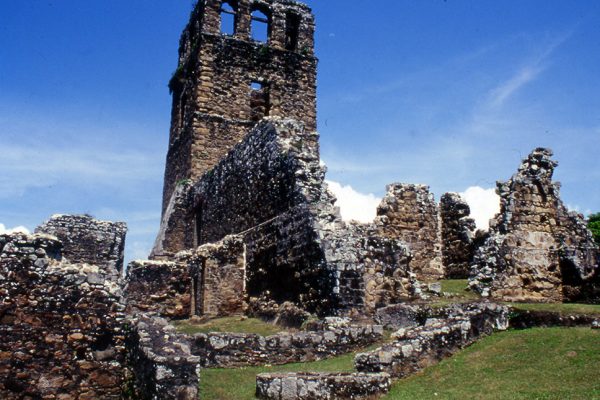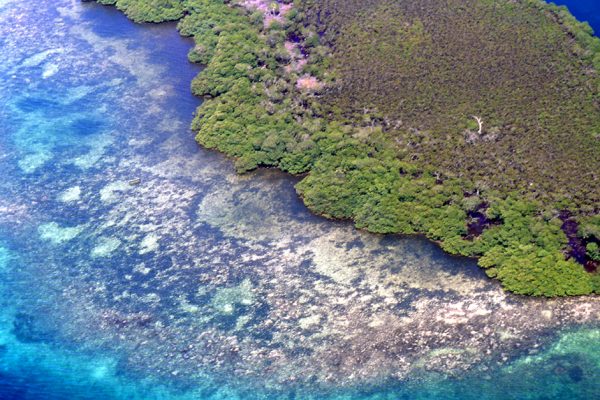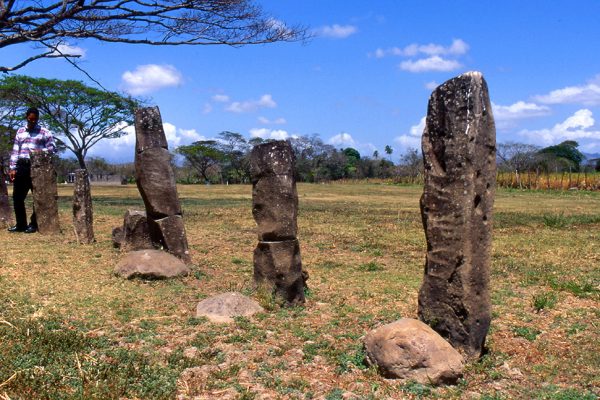From April 1998 through March 2000, Dr. Ayala carried out the Tourism-Conservation-Research (TCR) Action Plan for the Republic of Panama, at the invitation of the Panamanian Government of President Ernesto Pérez Balladares and under the auspices of the Panamanian Tourism Institute (IPAT). This national project was formalized via Panama’s Executive Decree No. 327 of 30 November 1998.
In the words of Dr. Ceferino Sánchez, who led—as then National Secretary of Science, Technology, and Innovation—the Panamanian Government’s participation in, and support for, the TCR Action Plan:
The Tourism-Conservation-Research Action Plan is an innovative opportunity…in which our country’s natural capital, geographical features, cultural heritage, and geological history are conjoined to generate sustainable tourism development, a solvent conservation policy, and an ever-increasing knowledge baseof our nation’s assets.
(in: Cornell Hotel and Restaurant Administration Quarterly, October 1998, p. 76)
TCR had all the characteristics needed to be the national project we sought. It had the combination of leadership, imagination, freshness…
(speaking at the Arnold and Mabel Beckman Center of the National Academies of Sciences and Engineering on 22 September 2005)
The principal achievements include:
Support and Participation of the Smithsonian. The TCR Action Plan has enabled Panama to be the first country to link the tourism and hotel industry with the world renown of the Smithsonian Institution. This ground-breaking initiative (catalyzed by the Panama-based Smithsonian Tropical Research Institute/STRI and funded by the Smithsonian Institution, the Tinker Foundation of New York, and other sources) offers a novel economic opportunity to transform the Smithsonian’s prestigious geological, biological, and cultural research into the impossible-to-imitate qualities of Panama’s heritage products, while fostering education, conservation, and sustainable development.
Did she mean that STRI would be expected to give practical advice upon which other people would be making substantial financial investment?…Here our work is expected to have an immediate relevance to society. Well, why not?…I am happy to pledge STRI’s participation.”
Dr. Ira Rubinoff
Director (1974-2008), Smithsonian Tropical Research Institute
(in: Conservation Panama: Exploring Options for the Future. U.S. Department of Defense Legacy Resource Management Program, 1998, pp. 2-5)
Conservation Panama: Exploring Options for the Future
(presentations by Dr. Rubinoff and Dr. Ayala)
La Dra. Ayala expuso una tesis en extremo original…que eleva la ciencia, la geología, la ecología y la complejidad cultural de nuestra nación a prioridad No. 1 con un arreglo de reciprocidad de beneficios con la industria turística…Ve como ventajas claras y contundentes nuestra singular situación en biodiversidad; la presencia aquí del Smithsonian Research Institute…estaríamos, como país, pasando a la vanguardía mundial del nuevo turismo del conocimiento.
[Dr. Ayala advanced an extremely original thesis…one that raises the science, geology, ecology, and the cultural complexity of our nation to a No. 1 priority, with benefits that would be shared with the tourism industry…She sees as clear and definitive advantages our singular biodiversity endowment; the presence of the Smithsonian Research Institute…as a country, we would be moving to the global forefront of the new knowledge tourism.]
I. Roberto Eisenmann, Jr.
Co-Founder, Editor, and Publisher, La Prensa (Panama)
(“Hana Ayala y el Nuevo Turismo Panameño,” La Prensa, 3 July 1997)
TCR Heritage Themes. The involvement of STRI’s executives and lead experts injected cutting-edge substance into the TCR Action Plan’s key outcome, a nation-wide network of 23 heritage routes based on themes that span Panama on various spatial scales, reach millions of years back in time, and reveal the unparalleled geological, ecological, and cultural dynamics of Panama as the “bridge of the world.” This network supplied an original instrument for presenting, protecting, and enhancing the national heritage while energizing the national economy. It anchored a pilot union of TCR hotel partners and inspired vanguard architectural, legal, and capacity-building models and strategies developed with the participation of renowned experts and distinguished academic institutions.
Con el apoyo incondicional del Instituto Smithsonian de Investigaciones Tropicales, Hana Ayala elabora su plan de acción sustentado en los estudios de las rutas que históricamente transitaron el istmo; además de la singularidad de los tres océanos que modulan este territorio (científicamente, el Pacífico oeste es tan diferente del Pacífico este, que se consideran como dos mares distintos). Toda esta información es sobrepuesta sobre el mapa de la composición socioeconómica, para concluir claramente que las áreas de mayor potencial de desarrollo turístico coinciden con las áreas de mayor pobreza en la República. Esta situación da al proyecto TCI un potencial excepcional, para convertirse en el motor de
cambio social en el país.
[With the unconditional support of the Smithsonian Tropical Research Institute, Hana Ayala elaborates an action plan substantiated in the studies of the routes that historically crossed the isthmus; in addition to the singularity of the three oceans that modulate this territory (scientifically, the western Pacific and the eastern Pacific are considered two different seas). All this information is superimposed on the map of the socioeconomic structure, to clearly conclude that the areas of the greatest potential for tourism development coincide with the areas of greatest poverty in the Republic. This situation endows the TCR project with an exceptional potential to become the engine of the
nation’s social change.]
Alvaro Gonzáles Clare, architect
(“El TCI,” La Prensa, 13 March 2000)
…una parte crucial del concepto TCI, elaborado por Ayala, es el desarrollo de 22 rutas patrimoniales…Las rutas están diseñadas para revelar la dinámica convergencia de factores geológicos, culturales, históricos y ecológicos que han convertido a Panamá en “Puente del mundo”…Lo más valioso de estas “rutas patrimoniales” es que ningún país les podrá duplicar, porque dependen de recursos naturales, científicos y culturales que únicamente se encuentran en Panamá. Además, son atractivos turísticos que constantemente evolucionan, maduran y crecen.
[…a crucial part of the TCR concept, elaborated by Ayala, is the development of 22 heritage routes…The routes are designed to reveal the dynamic convergence of geological, cultural, historical and ecological factors that have transformed Panama into the “Bridge of the world”…The greatest value of these “heritage routes” is that no country can duplicate them, since they depend on natural, scientific, and cultural resources that are only found in Panama. Moreover, they are tourism attractions that continuously evolve, mature,
and grow.]
Betty Brannan Jaén
Washington, D.C. Correspondent, La Prensa
(“Una Propuesta Prometedora,” La Prensa, 26 July 1999, p. 6A)
TCR Pilot Hotel Portfolio. Under the TCR Action Plan’s guidance, fifteen hotels in Panama pledged and contributed close to US$5 million for science, conservation, education (including scholarships for the indigenous people), and sustainable development of the local communities. These highly marketable pledges extol the TCR model’s ability to mobilize and fund employment in conservation and resource management.
…Hana Ayala with her revolutionary ideas about linking tourism with conservation and research. I had always thought that ecotourism should be an instrument of conservation, more than an end in itself. But Hana went farther: tourism in general, the biggest and wealthiest industry in the world, should be a patron of conservation and research, two activities that are essential for human development in its broadest sense, but that are usually short of funds. And this link would not be merely because of civic-minded reason but because it is also good business. Needless to say, I readily enlisted in her crusade to transform tourism in Panama and here I am enthusiastic proponent of this new strategy.
Raúl Arias de Para
President and Founder, Canopy Family
(“The Canopy Tower,” in: TCR Strategic Alliance: Tourism, Conservation, Research. A Report from the Conference on “Heritage Tourism for the Next Millennium,” Marina S. Ratchford, editor. Washington, DC: American Association for the Advancement of Science, 1998, pp. 57-58)
Panama’s Canopy Tower: A Pilot Project of the TCR Alliance
TCR’s Infrastructure Blueprint. At Dr. Ayala’s invitation, Pritzker Prize winner and internationally acclaimed architect Frank O. Gehry joined the TCR Action Plan and led a team of experts charged with developing conceptual and feasibility studies for prototypes of TCR infrastructure in the context of the Panama Canal. The products include three Gehry-designed models of heritage interpretive centers.
Ayala también estableció una relación de trabajo estrecha con el reconocido arquitecto Frank O. Gehry. Ella misma era la mediadora y guía del concepto “infraestructura TCI”, Gehry y un equipo de arquitectos desarrollaron estudios de factibilidad para prototipos en el contexto del Canal de Panamá. Producto de este esfuerzo, surgieron tres modelos de centros patrimoniales –en Amador, Sherman y Colón– todos con el diseño de Gehry.
[Ayala established a close working relationship with the renowned architect Frank O. Gehry. She herself was the mediator and guide of the “TCR infrastructure” concept, Gehry and a team of architects developed feasibility studies for prototypes in the context of the Panama Canal. This effort yielded three models of heritage centers—in Amador, Sherman, and Colón—all designed by Gehry.]
(Eva Aguilar and Abey Saied, “Cuando la Conservación Paga,” Martes Financiero, 25 May 2004, pp. 8-10)
There is a lot of interest in this conference and in Panama…We are all here because of Hana’s infectious energy and because we want to help. We want to be a part of it.
Frank O. Gehry
(Frank O. Gehry, “Keynote Speech,” in: TCR Strategic Alliance: Tourism, Conservation Research. A Report from the Conference on “Heritage Tourism for the Next Millennium,” Marina S. Ratchford, editor. Washington, DC: American Association for the Advancement of Science, 1998, pp. 25-26)
Como subproductos del proyecto, Hana Ayala ha logrado interesar al prestigioso arquitecto Frank Gehry, diseñador del museo Guggenheim en Bilbao, para que produzca no uno sino tres proyectos que, en su expresión arquitectónica, celebren la biodiversidad de Panamá mediante formas constructivas que serán sin duda otra revolución en el mundo arquitectónico. De igual forma ha logrado que la Asociación Americana de Avance de la Ciencia (AAAS) avale el proyecto internacionalmente y apoye la iniciativa. Además ha logrado promover conjuntamente con la Ciudad del Saber, lo que Hana Ayala define como el ‘‘encierro interdisciplinario’’, que incluye nueve áreas de expertise comprometiendo la participación de instituciones locales e internacionales…
[As subproducts of the project, Hana Ayala has won the interest of the prestigious architect Frank Gehry, designer of the Guggenheim museum in Bilbao, to produce not one but three projects that, in their architectural expression, celebrate Panama’s biodiversity via structural forms that, no doubt, will once more revolutionize the architectural world. Similarly, she has secured the support and endorsement of the American Association for the Advancement of Science (AAAS) for the project at an international level. Moreover, Hana Ayala has promoted, jointly with the City of Knowledge, what she defines as the “interdisciplinary cluster,” which includes nine areas of expertise and counts with the involvement of local and international institutions.]
(Alvaro Gonzáles Clare, “El TCI,” La Prensa, 13 March 2000)
TCR Action Plan’s Legacy. An awakening of political and business leaders and media—in Panama and internationally—to the combined worth of the nation’s heritage riches and STRI’s world-class research for securing a market position of international prominence, and equipping Panama with the means and the momentum for activating this opportunity, became the core accomplishments of the TCR Action Plan for Panama.
Spearheading this mammoth effort is Dr. Hana Ayala…who has been working closely with the Panamanian government and local developers to establish guidelines to ensure ecological and financial stability in the new millennium. Emphasizing Panama’s unique topographical and cultural bounty—from its rainforests and parks to its extensive flora and fauna and ethnically diverse native groups—Dr. Ayala is aggressively laying the groundwork for a “heritage-driven economy” through an action plan that links tourism, conservation and research (TCR). Key players in the TCR Action Plan include existing hotels; new resort developments; Panama Hotel Association; the Smithsonian Tropical Research Institute, which is based in Panama; Autoridad de la Region Interoceanica, the government agency promoting investment in and around the Canal Zone; and a new international design team headed by architectural superstar Frank Gehry.
(Hotels, March 1999, p. 44)
…the flagship Tourism-Conservation-Research (TCR) strategic alliance…‘‘Only if sustainable resource management is brought as a financial incentive and an employment opportunity into the tourist trade can the selling of heritage experiences meet the highest standard of product quality while catalyzing economies that will prosper on sustainability,” said Hana Ayala.
(Science, 28 May 1999, p. 1546)
The project in Panama, known as the Tourism-Conservation-Research (TCR) Action Plan, is the brainchild of Hana Ayala…has an impressive list of partners, including the Smithsonian Tropical Research Institute (STRI) and the American Association for the Advancement of Science.
(Scientific American, December 1999, p. 26)
Tourism-Conservation-Research Alliance (TCR)…supported by, among other lofty institutions, the United Nations Development Program. Spearheading the effort is Hana Ayala, an economic development expert and former professor at the University of California.
(Civilization—The Magazine of the Library of Congress, December 1999/January 2000, p. 5)
…el nuevo plan TCI en que Panamá será pionero…es creación original de Hana Ayala…su plan TCI podría ser “el puente que una al país,” por encima de divisiones políticas y sociales, en un esfuerzo compartido para su desarrollo económico.
[…the new TCR plan in which Panama will be the pioneer…is an original creation of Hana Ayala…her TCR plan could be “the bridge that unites the country,” above political and social divisions, in a shared effort for economic development.]
(La Prensa, Panama, 26 July 1999, p. 6A)
Las nuevas “economías del conocimiento” serán aquellas que revolucionarán el futuro y ofrecerán las mayors ventajas competitivas…países como Panamá, abundante en riquezas naturales y culturales tienen la oportunidad de replantear el rumbo de sus economías basándose en un concepto de desarrollo mucho más sostenible. Tal modelo ya existe…“Turismo para la Conservación a través de la Investigación”, mejor conocido como TCI, en el cual las reservas patrimoniales de Panamá cobran un papel estelar.
[The new “knowledge economies” will revolutionize the future and offer the greatest competitive advantages…countries like Panama, abounding in natural and cultural riches, have the opportunity to change the course of their economies on the basis of a much more sustainable development concept. Such model already exists…”Tourism for Conservation through Research,” better known as TCR, in which Panama’s heritage reserves play a stellar role.]
(Martes Financiero, Panama, 25 May 2004, p. 8)
(see also references in the “Press Room”)



